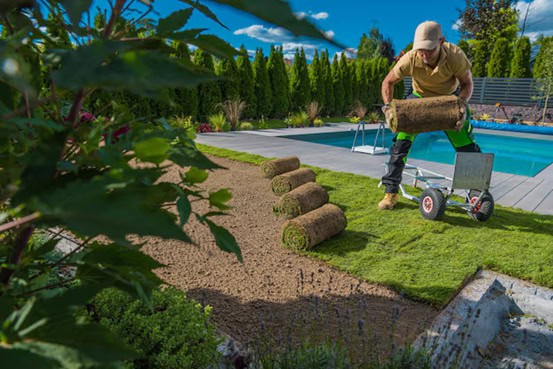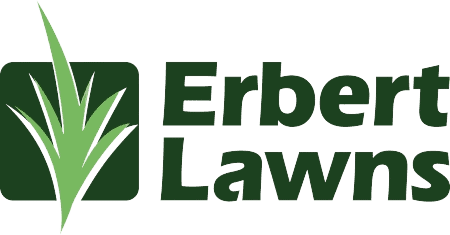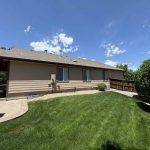
A lush, green lawn doesn’t happen by accident—it requires care, attention, and timely renovation. At Erbert Lawns, we specialize in bringing tired, patchy, and damaged lawns back to life. Whether your lawn has suffered from drought, pests, or compacted soil, the right approach to reseeding, dethatching, and soil amendments can restore its vitality and resilience.
Key Takeaways
- Reseeding restores density and improves lawn resilience.
- Dethatching removes excess organic matter, enhancing water and nutrient flow.
- Aeration loosens compacted soil, allowing deeper root growth.
- Soil amendments improve fertility, ensuring long-term lawn health.
- Seasonal renovation keeps your lawn green, thick, and vibrant.
Understanding Lawn Renovation
Lawn renovation goes beyond basic mowing and watering—it’s about identifying underlying issues and implementing targeted solutions. If your lawn has bare patches, excessive thatch, or thinning grass, a structured renovation plan can rejuvenate it.
Why Lawn Renovation Is Necessary
Lawns can become damaged for a variety of reasons. Heavy foot traffic, pest infestations, disease, harsh weather conditions, or poor soil quality can all contribute to a lawn that’s less than perfect. Sometimes, lawns may become patchy or thin due to a combination of factors, including mowing errors, watering issues, or nutrient deficiencies. If left untreated, these issues can lead to a lawn that is weak, unsightly, and prone to further damage.
Understanding the basics of lawn renovation is essential for restoring a healthy and vibrant lawn. Renovating your lawn not only fixes these issues but also helps prevent further problems. It encourages healthy grass growth, improves soil health, and reduces the need for excessive chemical treatments. Lawn renovation can be done at any time during the growing season, but it’s typically best performed during early spring or fall, when temperatures are moderate and grass growth is at its peak. Lawn care services can help address lawn issues by providing professional care to rejuvenate your lawn.
Step 1: Reseeding Your Lawn
Reseeding is one of the most common and effective methods of lawn renovation. Over time, grass can thin out due to environmental stress or disease. Reseeding helps to replenish grass coverage and ensures a thicker, healthier lawn. Here’s how to reseed your lawn properly:
- Assess the Lawn’s Condition: Before beginning the reseeding process, evaluate the overall condition of your lawn. If you notice large areas of bare patches or thinning grass, reseeding will be the most effective solution. If the damage is more widespread, you might need to consider overseeding in combination with other renovation techniques like dethatching or aeration for lawn.
- Choose the Right Grass Seed: Select a type of grass seed that is suited to your climate, soil type, and lawn’s specific needs. Cool-season grasses like Kentucky bluegrass or fescue are ideal for cooler climates, while warm-season grasses like Bermuda or zoysia work best in hotter regions. Be sure to select a high-quality seed to ensure successful germination and growth.
- Prepare the Soil: For reseeding to be effective, the soil needs to be prepared properly. Begin by mowing the grass short, removing any debris, and loosening the soil using a rake or aerator. This allows the seed to make better contact with the soil and promotes better seed-to-soil contact. If your lawn is heavily compacted, consider aerating the soil to allow water, air, and nutrients to penetrate deeper into the root zone.
- Spread the Seed: After preparing the soil, spread the grass seed evenly across the lawn. A broadcast spreader can help ensure an even distribution of seed. Make sure to follow the recommended seed rate to avoid overcrowding the seeds, which could lead to poor growth.
- Water and Maintain: Once the seed has been spread, water the lawn thoroughly but gently to keep the soil moist. Avoid overwatering, as this can cause the seeds to wash away. Continue to water the area regularly, particularly during dry spells, to promote seed germination. The grass should begin to sprout within 7-21 days, depending on the type of seed and weather conditions.
Step 2: Dethatching the Lawn
Thatch is a layer of dead grass, roots, and organic matter that accumulates on the soil surface. While some thatch is beneficial for the lawn, too much of it can hinder water, air, and nutrients from reaching the grass roots. Dethatching helps to break up and remove excessive thatch, promoting better root growth and overall lawn health.
- Identify Thatch Build-Up: To determine if your lawn has too much thatch, check for a layer thicker than half an inch. If your lawn’s grass seems to struggle with growth, despite regular watering and fertilizing, excess thatch could be the culprit.
- Dethatching Tools: You can remove thatch using a dethatching rake or a dethatching machine. The latter is more effective for larger lawns or more severe thatch build-ups. A dethatching rake is a manual tool with tines that pull the thatch up to the surface for easy removal, while a dethatching machine uses vertical blades to slice into the soil and pull up the thatch.
- Dethatching Process: If using a dethatching machine, set it to a depth that will disturb the thatch but not harm the grass. Begin dethatching in one direction, then make a second pass perpendicular to the first pass to ensure thorough coverage. Rake up the debris left on the surface after dethatching.
- Post-Dethatching Care: After dethatching, the lawn will likely look a bit messy. Overseeding or reseeding is often recommended after dethatching to encourage new growth and restore the lawn’s appearance. Water the lawn thoroughly and continue regular care to promote recovery.
Step 3: Soil Amendments
The quality of the soil plays a significant role in the health of your lawn. Poor soil can result in weak grass that struggles to thrive, even with regular watering and maintenance. Soil amendments help improve the structure, pH, and nutrient content of the soil, making it easier for grass to grow and thrive.
- Test Your Soil: A soil test is the best way to determine your soil’s nutrient levels and pH. Testing kits are available at garden centers, or you can send a sample to a local extension office for analysis. The results will provide recommendations for the right amendments your soil may need.
- Amend the Soil: Based on the soil test results, you may need to apply specific amendments. Conversely, if the soil is too alkaline, sulfur can help lower the pH. Organic matter like compost or well-rotted manure can also improve soil structure, increase moisture retention, and add essential nutrients.
- Aeration: If your lawn has compacted soil, aerating the soil by poking small holes in the ground can help water and nutrients reach the roots more effectively. Aerating is especially important after dethatching or reseeding, as it allows for better root development and ensures the soil amendments work their way into the ground.
Conclusion
A well-maintained lawn boosts your home’s curb appeal and provides a healthier outdoor space. At Erbert Lawns, we offer expert lawn renovation services to bring your lawn back to life. Ready to restore your lawn? Contact Erbert Lawns today for professional lawn renovation services tailored to your needs.
FAQs:
When is the best time to renovate my lawn?
The best time for lawn renovation is in early autumn or spring, when temperatures are moderate and grass growth is at its peak.
How often should I aerate my lawn?
Most lawns benefit from annual aeration, though high-traffic areas may require aeration twice a year.
What causes excessive thatch, and how do I prevent it?
Excessive thatch is caused by over-fertilization, compacted soil, and improper mowing. Regular dethatching and aeration can help prevent buildup.
Can I reseed my lawn without aerating?
While reseeding alone can improve lawn density, combining it with aeration enhances seed-to-soil contact, improving germination rates.
How long does it take for new grass to grow after reseeding?
Depending on the grass variety, germination typically occurs within 7-21 days, with visible growth within 4-6 weeks.
Do I need to fertilize after lawn renovation?
Yes, Applying a starter fertilizer after reseeding or aeration provides essential nutrients for strong root development.










